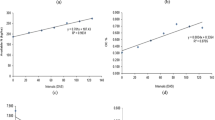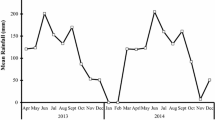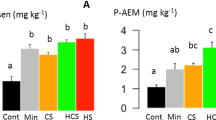Abstract
Sesbania sesban was evaluated as green manure crop for lowland rice in the Dry Zone of Sri Lanka. The legume was grown during a fallow period before lowland rice (Oryza sativa) and ploughed under just before transplanting. Weight loss and nitrogen content in litterbags containing leaves, stems and roots of the legume were monitored. Comparisons were made between rice yields from 20 m2 plots after green manuring in combination with different nitrogen fertilizer levels (0, 2.4, 4.8 and 7.2 gm−2) and nitrogen fertilizer (9.6 gm−2) alone. Above-ground biomass ofS. sesban was 440 gm−2 (dry wt) when ploughed under after 84 days growth. N-content in leaves, stems and roots was 3.76%, 0.41% and 0.73%, respectively. This gave a N-input fromS. sesban of 9.2 gm−2 (8.3 g from above-ground parts and 0.9 g from roots). The corresponding K and P inputs were 7.3 and 0.6 gm−2 respectively. The nitrogen rich leaves, which contained 88% of the nitrogen in the above-ground parts, decomposed and released its nitrogen much more rapidly than the stems and roots. After only four days the leaves had released 5.3 g Nm−2 and after 14 days they had released 6.4 g Nm−2. The highest rice yield (505 gm−2) was obtained usingS. sesban and 4.8 gm−2 of N-fertilizer. The yields with only N-fertilizer or onlyS. sesban were 442 gm−2 and 396 gm−2, respectively. Due to the rapid decomposition of the nitrogen rich leaves,S. sesban did not behave as a slow release fertilizer. Thus, it is not necessary to apply nitrogen fertilizers as a basal dose.
Similar content being viewed by others
References
Alazard D and Becker M 1987 Aeschynomene as green manure for rice. Plant and Soil 101, 141–143.
Bajpai P D, Ranjana Arya Km and Gupta B R 1980 Comparative studies on decomposition pattern of some plant materials in two different soil conditions during winter season. Indian J. Agric. Res. 14, 91–102.
Bery V and Meelu Q P 1981 Substitution of nitrogen through green manure in rice. Indian Farming 31, 3–4.
Bhardwaj K K R and Dev S P 1985 Production and decomposition ofSesbania cannabina (Retz.) Pers. in relation to its effect on the yield of wetland rice. Trop. Agric. 62, 233–236.
Ghai S K, Rao D L N and Batra L 1985 Comparative study of the potential of sesbanias for green manuring. Trop. Agric. 62, 52–56.
Domrös M 1974 The Agroclimate of Ceylon. Franz Steiner Verlag, Gmbh, Wiesbaden.
Dreyfus B, Rinaudo G and Dommergues Y 1985 Observation on the use ofSesbania rostrata as green manure in paddy fields. MIRCEN J. 1, 111–121.
Evans D O and Rotar P P 1987 Productivity ofSesbania species. Trop. Agric. 64, 193–200.
Herdt R W and Stangel P J 1984 Population, rice production, and fertilizer outlook. pp 1–34.In Organic Matter and Rice. IRRI, Los Banos, Philippines.
Koyama T and App A 1979 Nitrogen balance in flooded rice soils. pp 95–104.In Nitrogen and Rice. IRRI, Los Banos, Philippines.
Morris R A, Furoc R E and Dizon M A 1986 Rice responses to a short-duration green manuring. I. Grain yield. Agron. J. 78, 409–412.
Nykvist N 1963 Leaching and decomposition of water-soluble organic substances from different types of leaf and needle litter. Studia Forestalia Suecica. 3. 31 p.
Olsen S R, Cole C V, Watanabe F S and Dean L A 1954 Estimation of available phosphorus in soils by extraction with sodium bicarbonate. U S Dep. of Agric. Circ. 939.
Palm O and de Silva M A P 1987 Nutrient cycling in paddy rice of a traditional farming system, Dry Zone, Sri Lanka. Trop. Agric. 64, 129–133.
Patnaik S 1978 Natural sources of nutrients in rice soils. pp 501–519.In Soils and Rice. IRRI, Los Banos, Philippines.
Pratt P F 1965 Potassium.In Methods in Soil Analysis. Part II Chemical and Microbiological Properties. No. 9 in series Agronomy. Ed. C A Black, pp 1022–1030. Am. Soc. Agron. Inc. Madison, Wisconsin USA.
Rinaudo G, Dreyfus B and Dommergues Y 1983Sesbania rostrata green manure and the nitrogen content of rice crop and soil. Soil Biol. Biochem. 15, 111–113.
Rosswall T 1981 The biogeochemical nitrogen cycle.In Some Perspectives of the Major Biogeochemical Cycles. Ed. G E Likens, pp 25–49. John Wiley and Sons, New York.
Saint Macary H, Marqueses E P, Torres R O and Morris R A 1985 Effect of flooding on growth and nitrogen fixation of twoSesbania species. Philipp. J. Crop Sci. 10, 17–20.
Singh P K, Panigrahi B C and Satapathy K B 1981 Comparative efficiency of azolla, blue-green algae and other organic manures in relation to N and P availability in a flooded rice soil. Plant and Soil 62, 35–44.
Singh N T 1984 Green manure as sources of nutrients in rice production.In Organic Matter and Rice. pp 217–228. IRRI, Los Banos, Philippines.
Swift M J, Heal O W and Anderson J M 1979 Decomposition in Terrestrial Ecosystems. Studies in Ecology, 5. Blackwell Scientific Publications, Oxford. 372 p.
Tiwari K N, Pathak A N and Ram H 1980 Green-manuring in combination with fertilizer nitrogen on rice under double cropping systems in an alluvial soil. J. Indian Soc. Soil Sci. 28, 162–169.
Triman H 1894 A Hand-book to the Flora of Ceylon. Part II. DULAU & CO, London.
Weerakoon W L and Gunasekera T G L G 1985In situ application ofLeucaena leucocephala (Lam) De Wit. as a source of green manure in rice. Sri Lankan J. Agric. Sci. 22, 20–27.
Weerakoon W L and Seneviratne A M 1984 Managing a sustainable farming system in the Dry Zone of Sri Lanka. Trop. Agriculturist (Sri Lanka) 140, 41–50.
Wijewardene R and Waidyanatha P 1984 Conservation farming — systems, techniques and tools. Dept. of Agriculture, Sri Lanka and the Commonwealth Consultative Group on Agriculture for the Asia-Pacific Region.
Author information
Authors and Affiliations
Rights and permissions
About this article
Cite this article
Palm, O., Weerakoon, W.L., de Silva, M.A.P. et al. Nitrogen mineralization ofSesbania sesban used as green manure for lowland rice in Sri Lanka. Plant Soil 108, 201–209 (1988). https://doi.org/10.1007/BF02375650
Received:
Revised:
Issue Date:
DOI: https://doi.org/10.1007/BF02375650




